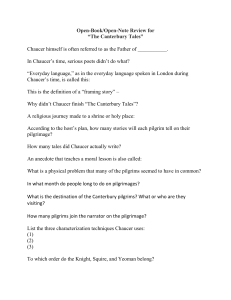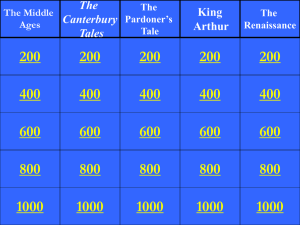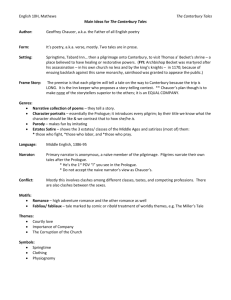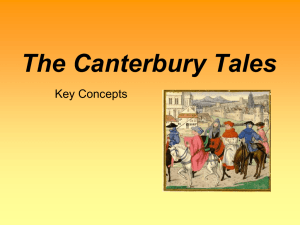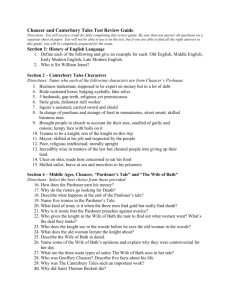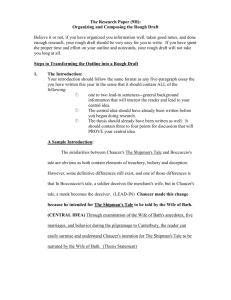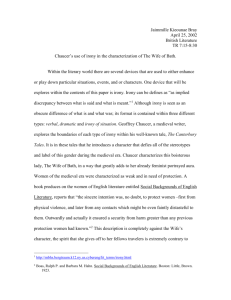Canterbury Tales Study Guide
advertisement
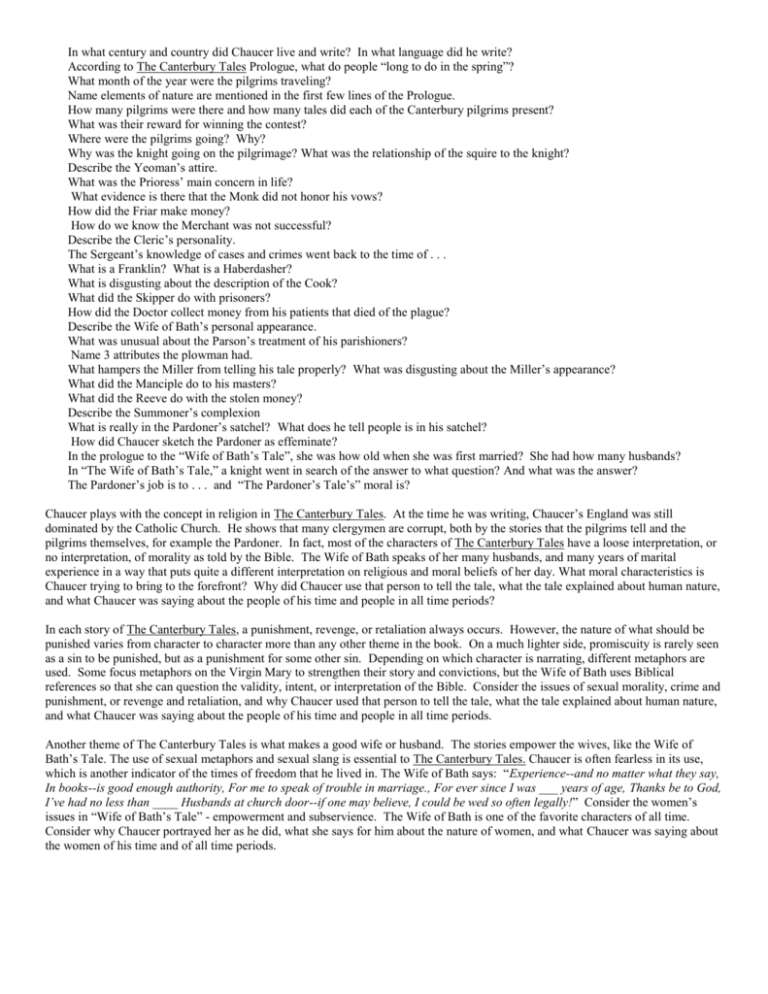
In what century and country did Chaucer live and write? In what language did he write? According to The Canterbury Tales Prologue, what do people “long to do in the spring”? What month of the year were the pilgrims traveling? Name elements of nature are mentioned in the first few lines of the Prologue. How many pilgrims were there and how many tales did each of the Canterbury pilgrims present? What was their reward for winning the contest? Where were the pilgrims going? Why? Why was the knight going on the pilgrimage? What was the relationship of the squire to the knight? Describe the Yeoman’s attire. What was the Prioress’ main concern in life? What evidence is there that the Monk did not honor his vows? How did the Friar make money? How do we know the Merchant was not successful? Describe the Cleric’s personality. The Sergeant’s knowledge of cases and crimes went back to the time of . . . What is a Franklin? What is a Haberdasher? What is disgusting about the description of the Cook? What did the Skipper do with prisoners? How did the Doctor collect money from his patients that died of the plague? Describe the Wife of Bath’s personal appearance. What was unusual about the Parson’s treatment of his parishioners? Name 3 attributes the plowman had. What hampers the Miller from telling his tale properly? What was disgusting about the Miller’s appearance? What did the Manciple do to his masters? What did the Reeve do with the stolen money? Describe the Summoner’s complexion What is really in the Pardoner’s satchel? What does he tell people is in his satchel? How did Chaucer sketch the Pardoner as effeminate? In the prologue to the “Wife of Bath’s Tale”, she was how old when she was first married? She had how many husbands? In “The Wife of Bath’s Tale,” a knight went in search of the answer to what question? And what was the answer? The Pardoner’s job is to . . . and “The Pardoner’s Tale’s” moral is? Chaucer plays with the concept in religion in The Canterbury Tales. At the time he was writing, Chaucer’s England was still dominated by the Catholic Church. He shows that many clergymen are corrupt, both by the stories that the pilgrims tell and the pilgrims themselves, for example the Pardoner. In fact, most of the characters of The Canterbury Tales have a loose interpretation, or no interpretation, of morality as told by the Bible. The Wife of Bath speaks of her many husbands, and many years of marital experience in a way that puts quite a different interpretation on religious and moral beliefs of her day. What moral characteristics is Chaucer trying to bring to the forefront? Why did Chaucer use that person to tell the tale, what the tale explained about human nature, and what Chaucer was saying about the people of his time and people in all time periods? In each story of The Canterbury Tales, a punishment, revenge, or retaliation always occurs. However, the nature of what should be punished varies from character to character more than any other theme in the book. On a much lighter side, promiscuity is rarely seen as a sin to be punished, but as a punishment for some other sin. Depending on which character is narrating, different metaphors are used. Some focus metaphors on the Virgin Mary to strengthen their story and convictions, but the Wife of Bath uses Biblical references so that she can question the validity, intent, or interpretation of the Bible. Consider the issues of sexual morality, crime and punishment, or revenge and retaliation, and why Chaucer used that person to tell the tale, what the tale explained about human nature, and what Chaucer was saying about the people of his time and people in all time periods. Another theme of The Canterbury Tales is what makes a good wife or husband. The stories empower the wives, like the Wife of Bath’s Tale. The use of sexual metaphors and sexual slang is essential to The Canterbury Tales. Chaucer is often fearless in its use, which is another indicator of the times of freedom that he lived in. The Wife of Bath says: “Experience--and no matter what they say, In books--is good enough authority, For me to speak of trouble in marriage., For ever since I was ___ years of age, Thanks be to God, I’ve had no less than ____ Husbands at church door--if one may believe, I could be wed so often legally!” Consider the women’s issues in “Wife of Bath’s Tale” - empowerment and subservience. The Wife of Bath is one of the favorite characters of all time. Consider why Chaucer portrayed her as he did, what she says for him about the nature of women, and what Chaucer was saying about the women of his time and of all time periods.


